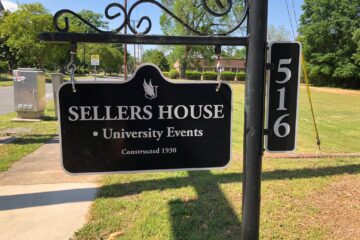It was one of four meetings addressing stakeholders as the team drafts their course of action and moves toward publication.
The committee is sponsored by president Edward Serna and chaired by Gary Simrill. It is partnered with Berkeley Research group– a consulting firm specializing in higher education–to help gather information. Together, they presented an audience of students with numbers, statistics and testimonials resulting from months of survey responses, focus groups and comparative research to determine the university’s strengths and weaknesses next to competing schools.
They shared with smiling faces that U.S. News ranked Winthrop as the fifth best public school in the South, according to an updated list published on Monday.
Joseph Miller, vice president for enrollment management and marketing, said freshman enrollment is up 22%–a high Winthrop hasn’t seen since 2018.
However, they also recognized room for improvement, which the Strategic Plan will help actualize over the next three to five years.
The Strategic Plan supports, but is separate from the Campus Master Plan directed by facilities management to improve campus infrastructure over the next 20 years.
In Serna’s words, “Strategic planning is a collaborative process by which we come up with a future state that we want to achieve as an institution; then, we create a roadmap on how we’re going to get there,” he said. “We’re not Clemson, we’re not (University of South Carolina), nor should we be. So how do we become the best version of Winthrop that we can be? What sets us apart?”
Students in the crowd were prompted to answer what makes Winthrop unique, and some of the responses were the welcoming community, diversity and program quality.
Next, attendees considered drawbacks that need attention. A few of those were space constraints, over-extended resources, inflexible curriculums and failing infrastructure, which were reflected in survey responses gathered in June.
There were over 800 participants, with 45% of them describing Winthrop positively overall, 41% negatively and 14% neutrally.
The Board of Trustees agreed on most of the initiatives in the survey, though there were mixed opinions on whether the institution should embrace diversity.
Simrill later said at the Ask Me Anything meeting on Thursday that differing responses probably had more to do with the wording of individual questions than with member’s attitudes. Colleges across the state are amending their Diversity, Equity and Inclusion statements to avoid controversy, but Simrill reiterated that Winthrop’s new Mission, Vision and Value statement makes diversity a priority.
He also said that Winthrop has never subscribed to Affirmative Action; rather, “We are diverse because we want to be.”
The issues aired in the survey were attributed to distinct subcommittees, each with a particular focus. They are called Excel, Educate, Enrich, Engage and Enhance.
Their leaders advocated for accelerated degree attainment, bolstered mental health services, philanthropy, community involvement and more.
Shelia Burkhalter, vice president of student affairs and representative of the Enriched group, said student success is a key motivator for expanding opportunities in and outside the classroom. Thus, so is student wellness.
She listed internships, academic advising and extracurricular activities–among other collaborative learning outlets–as means of expanding student’s perspectives and providing them with a robust educational experience.
Instilling a sense of belonging in students was a recurring theme presenters brought up throughout the evening. Simrill used his time at the podium to emphasize the importance of connecting with the community and building a mutually beneficial relationship with it.
“Go back and look at Winthrop coming to Rock Hill in the early 1890s. It was because the city of Rock Hill and the leadership here wanted this school in their community. It was a concerted effort. The bricks were given and the land was donated–there was a bond taken out. The president’s house belonged to a guy named Captain Stewart–he gave his house away to allow Winthrop to come to Rock Hill. If that doesn’t speak about community involvement and investment, nothing does,” Simrill said. “You are now a part of that very ideal.”
Students with remaining questions are encouraged to contact strategy@winthrop.edu.




